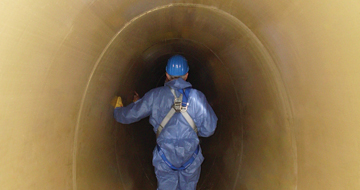
Rehabilitation with HOBAS Profiles 1260/2110 mm in Germany
The sewage of Würzburg’s approximately 125,000 inhabitants runs through a 540 km long sewer network, which has evolved over the years, to the wastewater treatment plant in Mainaustraße Street, where the water is then reprocessed. The Würzburg Sewage Board (EBW) performs regular checks on the city’s sewer network. In doing so, damages were detected at the so-called “Hauptsiel 1”, the main sewer leading to the wastewater treatment plant. Parts of the main sewer and the connected manhole structures are already more than 100 years old. The damages concerned in particular corrosion of the grouting, leaks, and groundwater infiltrations, which had been favored by the immediate proximity of the River Main. Many of the fittings for ventilation were cracked, and there were deposits at the bottom of the main sewer.
The egg-shaped brick sewer had no standard dimensions, but a special cross-section of 1400 x 2250 mm. For the rehabilitation of the 875 m long section, HOBAS NC Line Profiles 1260 x 2110 mm were used. Prior to the start of the actual rehabilitation works, the old sewer’s profile had to be digitized with a 3D laser scanner. The resulting three-dimensional image of the channel served as the basis for the installation plan. In another preparatory step, a water retention system had to be built. A diversion of the wastewater would not have been economically viable, which is why the works had to be interrupted in the event of rain so the channel could be abandoned within 30 min only – in the worst case, the channel would in fact be flooded. This flexibility is in fact one of the big advantages of relining. In order to guarantee a continuous on-the-job safety, a warning system with several level meters was installed. At the same time, a winding mandrel was produced and the HOBAS Pipes’ resin-rich inner liner applied to it. Afterwards, the non-circular pipe wall was built up by means of filament winding.
A total of 401 NC Line Profiles in lengths of 1 to 2.35 m and with a wall thickness of 25 mm were used in the rehabilitation of the old sewer. Due to the heavy traffic and the limited storage space on site, the GRP pipes’ delivery, storage, and installation had to be absolutely reliable and trouble-free. With the help of a so-called “pipe shuttle”, a carriage designed specifically for this project by the construction company Aarsleff, the pipes were lifted and transported to the construction pit. The installation works were conducted from one single pit, which is why 533 m pipes were installed in flow direction and another 342 m to the opposite direction. In the areas of manholes and special structures, the GRP profiles were cut open according to the manhole dimensions in order to create accesses and emergency exits. Then, the pipes were connected with push-to-fit couplings using a coupling device and secured against buoyancy by means of spacers. The 3 cm wide annular space was eventually grouted.
Nine months had been scheduled for the implementation of this project. Thanks to the continuous coordination of all involved parties, the installation was completed within 3 months, after no more than one third of the designated construction time. “All services were performed on time and on budget. We are also very satisfied with the technical implementation. The results of external quality inspections have proven that the decision to use GRP pipe relining for the rehabilitation of Hauptsiel 1 has been the right one. We would put this method out for tender again”, says Mr. Bergmann from EBW.
More information about this application
PROJECT DETAILS
| Project ID: [6508] | |
| Country: | Germany |
| City: | Wuerzburg |
| Year: | 2013 |
| Application: | Sewer |
| Installation: | Relining |
| Technology: | Hobas |
| Total Length: | 875 m |
| Nominal Diameter DN: | Non-Circular mm |
| Nominal Pressure PN: | 1 bar |
